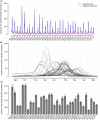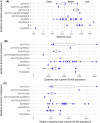Influenza epidemics observed in primary care from 1984 to 2017 in France: A decrease in epidemic size over time
- PMID: 30428158
- PMCID: PMC6379635
- DOI: 10.1111/irv.12620
Influenza epidemics observed in primary care from 1984 to 2017 in France: A decrease in epidemic size over time
Abstract
Background: Epidemiological analysis of past influenza epidemics remains essential to understand the evolution of the disease and optimize control and prevention strategies. Here, we aimed to use data collected by a primary care surveillance system over the last three decades to study trends in influenza epidemics and describe epidemic profiles according to circulating influenza viruses.
Methods: Influenza-like illness (ILI) weekly incidences were estimated using cases reported by general practitioners participating in the French Sentinelles network, between 1984 and 2017. Influenza epidemics were detected by applying a periodic regression to this time series. Epidemic (co-)dominant influenza virus (sub)types were determined using French virology data.
Results: During the study period, 297 607 ILI cases were reported allowing the detection of 33 influenza epidemics. On average, seasonal epidemics lasted 9 weeks and affected 4.1% of the population (95% CI 3.5; 4.7). Mean age of cases was 29 years. Epidemic size decreased over time by -66 cases per 100 000 population per season on average (95% CI -132; -0.2, P value = 0.049) and epidemic height decreased by -15 cases per 100 000 (95% CI -28; -2, P value = 0.022). Epidemic duration appeared stable over time. Epidemics were mostly dominated by A(H3N2) (n = 17, 52%), associated with larger epidemic size, higher epidemic peak and older age of cases.
Conclusions: The declining trend in influenza epidemic size and height over the last 33 years might be related to several factors like increased vaccine coverage, hygiene improvements or changing in influenza viruses. However, further researches are needed to assess the impact of potential contributing factors to adapt influenza plans.
Keywords: epidemics; influenza; influenza-like illness; primary care; surveillance.
© 2018 The Authors. Influenza and Other Respiratory Viruses Published by John Wiley & Sons Ltd.
Figures




Comment in
-
Letter to the Editor (reply to Souty C et al.): The causes of long-term trends in the epidemiology of influenza.Influenza Other Respir Viruses. 2019 May;13(3):305-306. doi: 10.1111/irv.12636. Epub 2019 Feb 27. Influenza Other Respir Viruses. 2019. PMID: 30810267 Free PMC article. No abstract available.
References
-
- Aguilera JF, Paget WJ, Mosnier A, et al. Heterogeneous case definitions used for the surveillance of influenza in Europe. Eur J Epidemiol. 2003;18(8):751‐754. - PubMed
-
- Thompson WW, Shay DK, Weintraub E, et al. Mortality associated with influenza and respiratory syncytial virus in the United States. JAMA. 2003;289(2):179‐186. - PubMed
-
- World Health Organisation . Influenza (Seasonal). In: Fact sheet, 2014. http://www.who.int/mediacentre/factsheets/fs211/en/. Accessed July 25, 2017.
-
- Grippenet.fr . Results of previous seasons. https://www.grippenet.fr/fr/resultats/saisons-precedentes/. Accessed July 17, 2018.
MeSH terms
LinkOut - more resources
Full Text Sources
Medical
Miscellaneous

